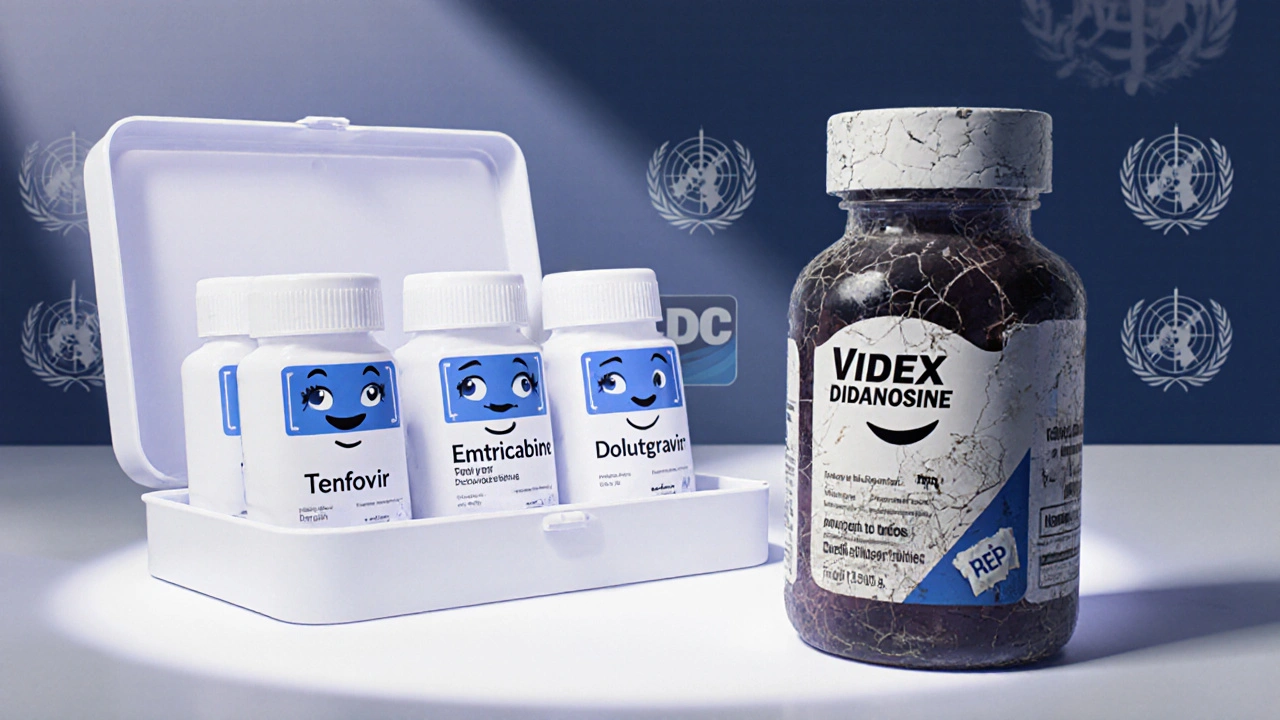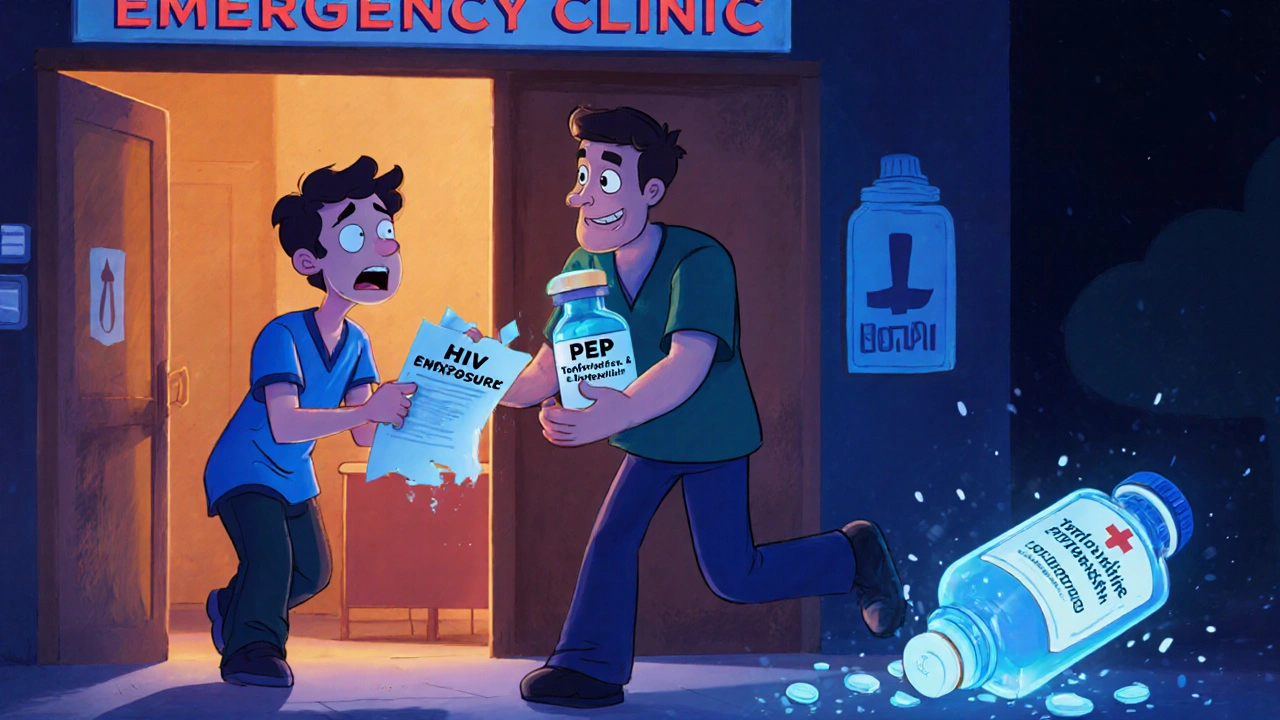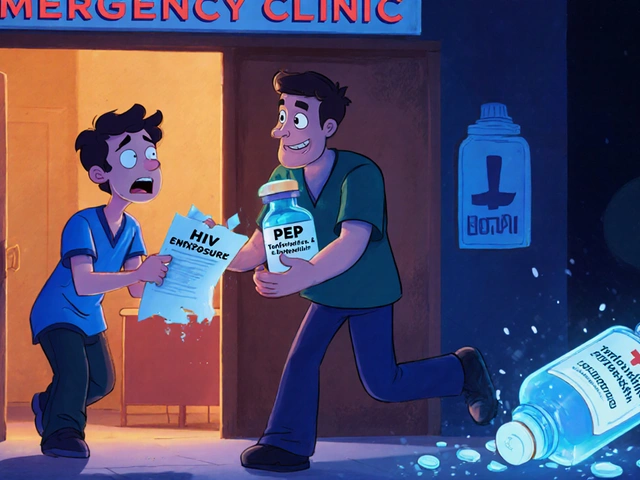Didanosine used to be a key drug in the fight against HIV, but today it plays almost no role in post-exposure prophylaxis (PEP). If you’re asking whether didanosine can stop HIV after a possible exposure, the short answer is: no, and it hasn’t been recommended for over a decade. The reason isn’t just about effectiveness-it’s about safety, side effects, and better alternatives that have completely replaced it.
What didanosine actually is
Didanosine, sold under the brand name Videx, is a nucleoside reverse transcriptase inhibitor (NRTI). It was approved by the FDA in 1991 and was one of the first antiretrovirals available. It worked by blocking HIV from copying its genetic material inside human cells. For years, it was part of combination therapy for people already living with HIV, especially when other drugs didn’t work or caused intolerable side effects.
But didanosine had serious downsides. It could cause life-threatening pancreatitis, liver damage, and peripheral neuropathy-nerve pain that felt like burning or tingling in the hands and feet. These risks weren’t rare. Studies from the early 2000s showed that up to 8% of patients on didanosine developed pancreatitis, and about 15% developed neuropathy over time. The drug also required strict dosing rules: it had to be taken on an empty stomach, at least two hours before or after food, because stomach acid broke it down too quickly.
Why didanosine was never part of standard PEP
Post-exposure prophylaxis (PEP) is a 28-day course of antiretroviral drugs taken within 72 hours after a potential HIV exposure-like a needlestick injury, unprotected sex, or sexual assault. The goal is to stop the virus from establishing a permanent infection. For PEP to work, the drugs must be safe enough for someone who doesn’t already have HIV to take for a month, effective at blocking the virus quickly, and easy to tolerate.
Didanosine failed on all three counts. Its side effect profile made it dangerous for healthy people. The dosing schedule was impractical-imagine having to wait two hours after every meal just to take a pill. And even when taken correctly, it wasn’t as potent as newer drugs. By the time PEP guidelines were formalized in the late 1990s and early 2000s, researchers were already looking at other NRTIs like tenofovir and emtricitabine, which were safer, more effective, and easier to take.
What PEP looks like today
Current PEP regimens, as recommended by the CDC and WHO, use combinations of three drugs from two classes: NRTIs and either an integrase inhibitor or a protease inhibitor. The most common regimen in the U.S. and Europe since 2013 has been tenofovir disoproxil fumarate (TDF) plus emtricitabine (FTC), combined with dolutegravir or raltegravir.
This combination works better than older regimens. Studies show it reduces HIV transmission risk by over 80% when taken correctly. It’s also much better tolerated. Side effects like nausea or headaches are mild and short-lived. Most people can take it with food, and there’s no need for complex timing rules. Tenofovir and emtricitabine are also used in PrEP (pre-exposure prophylaxis), which means doctors are very familiar with how they behave in the body.
Didanosine doesn’t appear in any current PEP guideline-from the CDC, WHO, British HIV Association (BHIVA), or European AIDS Clinical Society. It’s not listed as an option, not even as a backup. In fact, the U.S. Department of Health and Human Services officially removed didanosine from all HIV treatment guidelines in 2015, and it was withdrawn from the U.S. market in 2017.
What happened to didanosine?
Manufacturers stopped making didanosine because demand dropped to almost zero. By 2010, fewer than 1% of people on HIV treatment in the U.S. were still using it. The few remaining patients were switched to safer alternatives. The drug was never approved for use in children under 12 for PEP, and even in adults, it was never considered first-line.
Some countries with limited access to newer drugs may have used didanosine longer, but even there, it’s now largely obsolete. The World Health Organization’s 2021 guidelines for HIV treatment and prevention don’t mention didanosine at all. Global health organizations have moved on.
Why people still ask about didanosine
You might come across old articles, textbooks, or even forum posts from the early 2000s that list didanosine as an option for HIV treatment. That’s because it was used back then. But medicine doesn’t stand still. What was cutting-edge in 1998 is outdated in 2025.
Some people might confuse didanosine with other NRTIs like zidovudine (AZT), which was used in early PEP regimens but has since been replaced. Others might have heard stories from older patients who took it years ago and assume it’s still in use. But if you’re considering PEP after a recent exposure, didanosine is not an option-because it’s no longer available, not approved, and too risky.

What to do if you need PEP now
If you’ve had a possible HIV exposure, time matters. Go to an emergency room, sexual health clinic, or urgent care center within 72 hours. Don’t wait. Don’t search online for old drug names. Tell the provider exactly what happened-whether it was unprotected sex, a needle stick, or something else.
They’ll assess your risk and start you on the current standard PEP regimen: tenofovir/emtricitabine plus dolutegravir. You’ll get a 28-day supply, with follow-up tests at four to six weeks and again at three months. Most people complete the course without major issues.
If you’re allergic to one of the drugs in the standard regimen, doctors have alternatives-like switching dolutegravir to raltegravir or using abacavir instead of tenofovir. But didanosine is not one of them. It’s not in the toolbox anymore.
Final takeaway
Didanosine belongs in medical history books, not in your medicine cabinet. It had its time, but that time ended over ten years ago. Today’s PEP is faster, safer, simpler, and more effective. If someone tells you to take didanosine after a potential HIV exposure, they’re giving you advice from the past-and that advice could put your health at risk.
Always rely on current guidelines from trusted health organizations. If you’re unsure, ask a pharmacist or clinician. They’ll know exactly what to give you-and it won’t be didanosine.
Is didanosine still used for HIV treatment today?
No, didanosine is no longer used for HIV treatment or prevention. It was withdrawn from major markets like the U.S. and EU by 2017 due to serious side effects and the availability of safer, more effective drugs. Current treatment guidelines do not include it.
Can didanosine prevent HIV after exposure?
No, didanosine is not recommended or used for post-exposure prophylaxis (PEP). It was never part of standard PEP regimens due to its high risk of pancreatitis, liver damage, and nerve problems. Modern PEP uses tenofovir, emtricitabine, and dolutegravir instead.
Why was didanosine removed from HIV guidelines?
Didanosine was removed because newer drugs proved to be safer, more effective, and easier to take. Studies showed didanosine caused serious side effects in up to 15% of users, including life-threatening pancreatitis. Meanwhile, drugs like tenofovir and dolutegravir had fewer side effects and higher success rates in blocking HIV.
What should I take if I need PEP?
The standard PEP regimen today is tenofovir disoproxil fumarate (TDF) plus emtricitabine (FTC), combined with dolutegravir. This combination is taken once daily for 28 days. It’s highly effective, well-tolerated, and approved by global health authorities including the CDC and WHO.
Is didanosine available anywhere in the world?
Didanosine is no longer manufactured or distributed in most high-income countries. In some low-resource settings, it may have been used longer due to limited access to newer drugs, but even there, it’s being phased out. Global health organizations no longer recommend it, and it’s not stocked by major pharmaceutical suppliers.


okay so i just read this whole thing and like wow i had no idea didanosine was even a thing anymore i thought it was just some old school drug from the 90s like when people still used floppy disks and dial-up internet lol
but seriously though i had a cousin who was on it back in like 2003 and she said the side effects were brutal like she could barely walk because her feet felt like they were on fire and she had to eat like zero meals because of the timing thing
im so glad we moved on from that garbage i remember my mom used to scare me with stories about how HIV was a death sentence back then and now we got pills you take once a day with your morning coffee and you dont even think about it anymore
Big respect to the people who made this guide. This is the kind of info that actually saves lives. No fluff. Just facts. 👏
so didanosine was like the HIV version of that one phone from 2005 that kept crashing and no one knew why but everyone had to use it anyway 😅
now we got iphone 15 for hiv treatment lmao
you people are so naive. you think modern PEP is safe? tenofovir causes kidney damage in 12% of long-term users. dolutegravir? psychiatric side effects. they just replaced one toxic drug with two slightly less toxic ones. nobody talks about this because pharma owns the guidelines. didanosine was bad? sure. but at least it was honest about killing you slowly.
man i just got out of the er after a bad hookup and they gave me the peps combo they mentioned here
took the first pill like 45 min after it happened and honestly felt way better knowing i was on the right stuff
also the nurse was super chill and didn't make me feel like a mess for asking questions
thanks for the clarity on didanosine though i was totally gonna google it cause i remembered it from an old documentary
Oh, so you're telling me that after decades of medical progress, we finally stopped using a drug that caused pancreatitis in 8% of patients? Shocking. Truly. I'm just stunned that anyone ever thought this was acceptable. Also, I'm from the U.S., and we're still the only country with common sense. Europe? They're still using aspirin as a cure for the plague.
It’s fascinating how medicine evolves-not because we suddenly became smarter, but because we learned to prioritize safety over novelty.
Didanosine was a product of desperation: we were throwing everything at the wall to see what stuck. Today, we have data, we have ethics, and we have the luxury of choosing drugs that don’t turn your body into a warzone.
It’s not just about efficacy-it’s about dignity. Taking a pill shouldn’t mean risking your nerves, your pancreas, or your ability to eat dinner.
And yet… we still have people clinging to outdated ideas because they’re familiar. That’s not progress. That’s nostalgia dressed up as wisdom.
Let’s be real-didanosine was a pharmacological dumpster fire. NRTI? Sure. But the mitochondrial toxicity? The peripheral neuropathy? The damn dosing schedule? It was a clinical nightmare wrapped in a placebo effect.
Meanwhile, dolutegravir? Once-daily, no food restrictions, CNS penetration, high genetic barrier to resistance. It’s not even a comparison. The fact that people still ask about didanosine means we’re failing at medical education.
And yes, tenofovir has renal risks-but we monitor creatinine. We adjust. We don’t abandon science because one drug had side effects. We innovate. That’s what separates us from the 1990s.
Thanks for writing this. I was really worried after something happened last week and I didn’t know what to believe online. This made me feel calm. Just knowing what’s actually used now helps a lot.
you got this 💪
seriously though-anyone reading this who just had a possible exposure: don’t wait. don’t overthink it. go to urgent care. they’ve got this down to a science now. you’re not alone, and you’re not weird for asking. just go.
and no, you don’t need didanosine. you need help. and help is waiting.
didanosine was a mistake and now we have better options end of story
Of course someone’s still asking about didanosine. The internet is a museum of medical myths, and you just walked into the 1998 wing. Next you’ll ask if AZT is still used. It’s not. It’s 2025. Stop Googling old forums. Go to a clinic.
Didanosine? That’s what the rich people used before they discovered they could just pay for a better drug. Meanwhile, the rest of us are stuck with the leftovers. Classic. But hey, at least now the FDA lets us live a little longer before they kill us with a new pill.
just wanted to say this is one of the clearest explanations i’ve ever read about PEP evolution
i used to work in a clinic back in 2010 and we still had a few patients on didanosine because they couldn’t switch-insurance wouldn’t cover the new stuff
seeing them finally transition to tenofovir+dolutegravir was one of the best days of my job
side effects dropped by like 70% and people actually started taking their meds on time
medicine moves slow but when it moves right? it changes lives